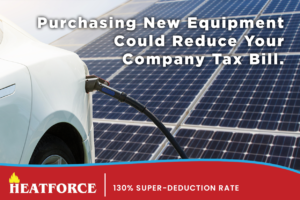
*Please note, the following information has been taken from HM Treasury and is correct at the time of writing – a link to the original document can be found at the bottom of this page.
Budget 2021 – Super-deduction
- For expenditure incurred from 1 April 2021 until the end of March 2023, companies can claim 130% capital allowances on qualifying plant and machinery investments.
- Under the super-deduction, for every pound a company invests, their taxes are cut by up to 25p.
- This change makes the UK’s capital allowance regime more internationally competitive, lifting the net present value of our plant and machinery allowances from 30th in the OECD to 1st.
The new Capital Allowances offer
As a result of measures announced at this Budget, businesses will now benefit from four significant capital allowance measures:
- The super-deduction – which offers 130% first-year relief on qualifying main rate plant and machinery investments until 31 March 2023 for companies
- The 50% first-year allowance (FYA) for special rate (including long life) assets until 31 March 2023 for companies
- Annual Investment Allowance (AIA) providing 100% relief for plant and machinery investments up to its highest ever £1 million threshold, until 31 December 2021
- Within Freeport tax sites, companies can access new Enhanced Capital Allowances (ECA+) and companies, individuals and partnerships can benefit from an increased level of Structures & Buildings Allowance (SBA+) for investments until 30 September 2026
Why is the government introducing a super-deduction?
- Since the Covid-19 pandemic, existing low levels of business investment have fallen, with a reduction of 11.6% between Q3 2019 and Q3 2020.
- Much of the UK’s productivity gap with competitors is attributable to our historically low levels of business investment compared to our peers. Weak business investment has played a significant role in the slowdown of productivity growth since 2008.
- Making capital allowances more generous works to stimulate business investment. As a result, these measures can promote economic growth and counter business cycles.
- The super-deduction will give companies a strong incentive to make additional investments and to bring planned investments forward.
A tax information and impact note for the policy, and draft legislation, is published here – Click here
What are capital allowances?
- Capital allowances let taxpayers write off the cost of certain capital assets against taxable income. They take the place of accounting depreciation, which is not normally tax-deductible. Businesses deduct capital allowances when computing their taxable profits.
- In translating its accounting profits into taxable profits, a business is usually required to ‘add back’ any depreciation, but can instead deduct capital allowances. For example, a corporation tax paying company with accounting profits of £1,000, depreciation expense of £200 and total capital allowance claims of £300 would make the following adjustment:
- Add £200 (depreciation expense) to £1,000 (accounting profits) = £1,200
- Deduct £300 (capital allowances) from £1,200 = £900 (taxable profits)
- Apply the appropriate tax rate, e.g. corporation tax at 19%: £900 x 19% = £171 tax due
The two main types of capital allowances are:
- Writing Down Allowances (WDAs) for plant & machinery – covering most capital equipment used in a trade; and
- Structures and Buildings Allowances (SBA) – covering the construction and renovation of non-residential structures and buildings.
- The 130% super-deduction and 50% first-year allowance are generous brand new capital allowances for investments in plant and machinery assets. Both will allow investing companies to lower their corporation tax bills.
What is plant and machinery?
Most tangible capital assets used in the course of a business are considered plant and machinery for the purposes of claiming capital allowances.
There is not an exhaustive list of plant and machinery assets. The kinds of assets which may qualify for either the super-deduction or the 50% FYA include, but are not limited to:
- Solar panels
- Computer equipment and servers
- Tractors, lorries, vans
- Ladders, drills, cranes
- Office chairs and desks,
- Electric vehicle charge points
- Refrigeration units
- Compressors
- Foundry equipment
For more detailed information, please view this HM Treasury link – Click here
Eligibility criteria are outlined in the published tax information and impacts note can be found here: click here
This scheme may be subject to change, and information is correct at the time of writing.
Full technical guidance will be published in due course by HM Treasury.

